Site menu:

July 2019 Newsletter
The Seven Whistler.
Colour Ring Report.
June Bird News.
Forthcoming Events.
Latest Newsletter.
The Seven Whistler

It was Jeff Clarke (ex Senior Ranger at Thurstaston - see Jeff Clarke
Ecology)
who told me that the old name for Whimbrel was the 'Seven Whistler'
because of it's distinctive seven whistle call. We only hear that call
for a few weeks as they pass through the estuary on their way north in
spring before returning south in late summer. Whimbrels don't
over-winter here so we only see them on migration making them something
special to look out for, particularly in late spring when the estuary
can otherwise be very quiet with many waders having already left us.
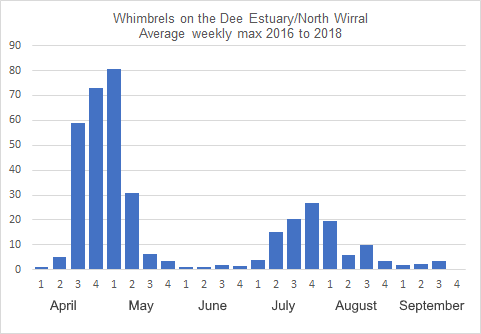
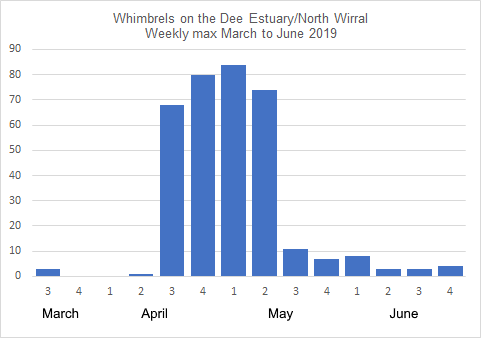
The majority of Whimbrels pass through the Dee estuary on their way north from mid-April to mid-May although in some years the migration can start as early as March and in 2011 two were recorded exceptionally early at Leasowe on February 23rd. We often get a few birds present in June including at least three at Heswall in 2019, presumably immature non-breeding birds which make the journey this far north without making the final flight to the breeding grounds. Numbers then increase through July and certainly by the second week breeding birds are returning and the southerly migration peaks in the last week of that month. Counts then decrease through August and into September and by October only one or two are left.
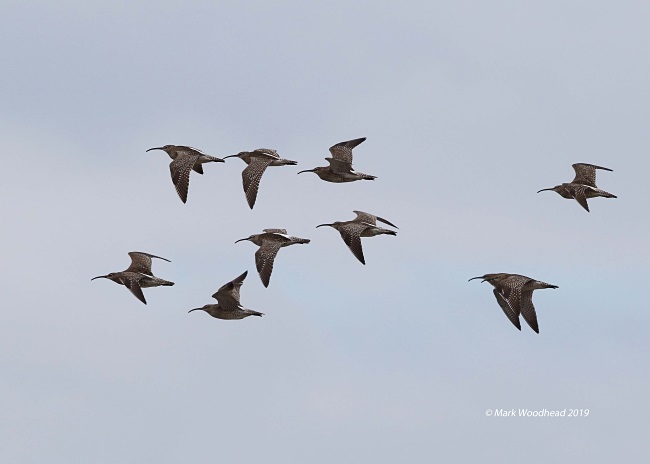
Where to find them
Whimbrels can turn up just about anywhere on the
estuary and north Wirral, from Leasowe Shore down to Burton Mere
Wetlands, and along the Welsh coast all the way to Gronant. But during
the main migration periods two sites almost guarantee good sightings -
Heswall and Hilbre. I've drawn up a graph of max annual counts for
Hilbre from 1973 to 2019 (2019 up to the end of June) and the trend
line (dotted line) suggests an increase in numbers over that period.
Coverage at Heswall has been nowhere near as good as Hilbre over that
period but again numbers have been higher there in recent years and all
three-figure counts have been over the past five years: 110 in 2012,
156 in 2014 and 131 in 2017, all during the spring migration. The 2014
count is the highest ever recorded for the Dee estuary.
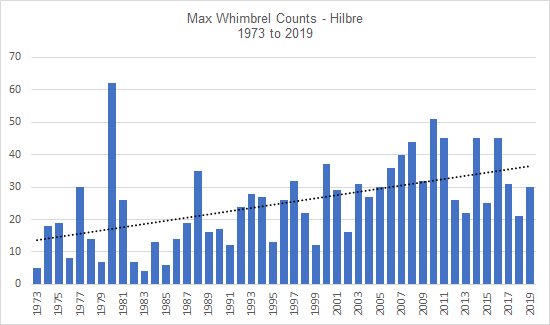
At Hilbre birds can easily be seen around the island at low tide and many roost on the west side at high tide, there is even a spot called 'Whimbrel's Rest' used regularly by them for many years. At Heswall on higher tides the birds roost in the marsh, rather hidden in the long grass. But they can be more easily seen on an incoming tide on the sand/mud banks, it's best to get down to Caldy at half tide and walk towards Thurstaston and Heswall - here you will see and hear the birds as they are pushed towards the shore as the tide rises. On lower tides some will roost on the rocks between Thurstaston and Caldy, or on the sand bank off Shore Cottage. If walking from the car park at Banks Road, Heswall, you need to get there at least two hours before high tide and walk towards Thurstaston where you should see the birds passing you on the way to the main roost site.
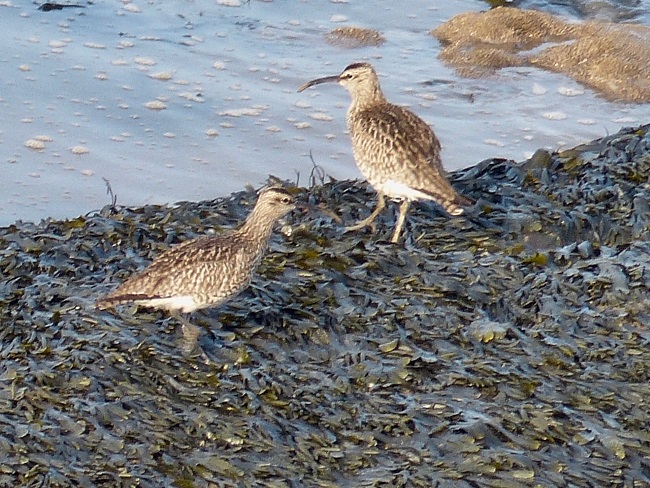
On the Dee estuary Whimbrels are usually observed
feeding on mudflats but they can also be seen in damp fields,
the paddocks near Leasowe Lighthouse seem to be to their liking
and in April 2019 a small flock of up to eight fed for several days
close to the footpath at the lighthouse end of Park Lane. Elsewhere,
there are sites in the UK where hundreds of Whimbrels feed in fields,
the most important being the area around Barnacre Reservoir in
Lancashire and here they roost at night with a massive 730 on May 3rd
2019, the highest count there since 847 in May 1998. The Reservoir is
private but there are guided walks in spring specifically to see this
spectacle.
Where are they coming from and where are they going?
We see two sub-species of Whimbrel in the UK - Icelandic breeding birds (Numenius phaeopus islandicus) and North-east Europe (Scandinavia and Baltic) breeding birds (N. p. phaeopus). It is estimated that around 250,000 pairs breed in Iceland and up to 110,000 pairs breed in north-east Europe with many more of the nominate race breeding in western Siberia. Whimbrels breed right around the northern hemisphere but, depending on which estimates you use for total numbers, between 25% and 40% of them breed in Iceland which is thus a vitally important country for them.
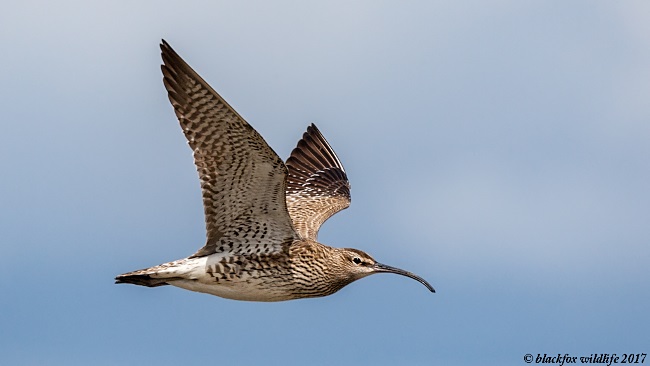
Both of these sub-species winter on the coast of
West Africa and perhaps all the way down to South Africa, with a few
wintering in Iberia. Although these wintering grounds have been
confirmed by observation, ringing and satellite tracking the large
majority of
birds, which must be in the region of at least one million, have never
been found. I quote Delany et al.
:
Counts of Whimbrel
at
their winter quarters in Africa can account for only a small proportion
of the populations concerned. Smit & Piersma (1989) could account
for only 69,000 islandicus
and phaeopus
combined, and recognised that this was a major underestimate. The total
from 1990s mid-winter counts and estimates was only slightly higher at
89,000 (Stroud et al. 2004). These low figures suggest that either the
main wintering areas in West Africa remain to be discovered, and/or
that the species is readily underestimated by counts in the wintering
areas. This might occur, for example, if a high proportion makes use of
mangroves, and/or the wintering range for this population extends
considerably further south in Africa than was previously believed
(Stroud et al. 2004). It is also possible that breeding numbers may
have been over-estimated.
(NOTE: Recent surveys in 2014 and 2015 have confirmed the high figure
of 250,000 pairs breeding in Iceland - Richard Smith)
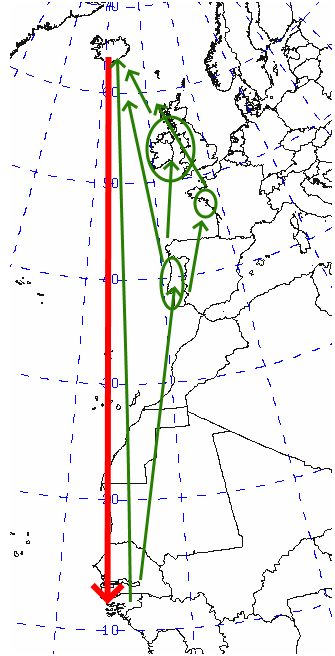 Between
2012 and 2015 40 adult Whimbrels in Iceland were fitted with
geolocators and this has shown (together with previous studies) that islandicus
birds fly direct from Iceland to Africa after breeding - a distance of
almost 4,000 miles. The study shows that for the spring migration some
birds, perhaps around half, stop over in Portugal, France, western UK
and/or Ireland. Ringing data had already suggested that the majority of
Whimbrel flying up the eastern side of the UK were heading for
north-east Europe and those on the west were heading to Iceland, so
this confirms that pattern. The birds we see here on the Dee estuary in
spring are therefore probably mostly islandicus
with some phaeopus, whilst
the return migration consists is likely to be wholly phaeopus. This would explain why,
as shown in the first graph, above, that we get more birds in spring
than in summer/autumn.
Between
2012 and 2015 40 adult Whimbrels in Iceland were fitted with
geolocators and this has shown (together with previous studies) that islandicus
birds fly direct from Iceland to Africa after breeding - a distance of
almost 4,000 miles. The study shows that for the spring migration some
birds, perhaps around half, stop over in Portugal, France, western UK
and/or Ireland. Ringing data had already suggested that the majority of
Whimbrel flying up the eastern side of the UK were heading for
north-east Europe and those on the west were heading to Iceland, so
this confirms that pattern. The birds we see here on the Dee estuary in
spring are therefore probably mostly islandicus
with some phaeopus, whilst
the return migration consists is likely to be wholly phaeopus. This would explain why,
as shown in the first graph, above, that we get more birds in spring
than in summer/autumn.
The map shows the
direct southward flight from Iceland to West Africa in autumn (red),
followed by the northward flight in spring (green) with some birds
taking a direct flight and others using staging areas in Portugal,
France, Ireland and western UK. Ireland seems to be a particularly
important stop off point. It can be seen that using one of these
staging areas does not add very much to the distance flown and
allows the birds to feed up and be in good condition for the final leg,
the Geo-locator data showed the birds typically stop for 10 to 15 days.
(Maps based on data/maps shown in Refs 7,8 and 9.)
References and Further Reading
1. Cheshire and Wirral Bird Reports -
1973 to 2017, CAWOS.
2. 2018 Whimbrel records kindly provided by CAWOS.
3. Steve Williams and Hilbre Bird Observatory, pers. comm. June 2019.
4. Allan Conlin, pers. comm. June 2019.
5. Sightings published in Dee Estuary Birding - http://www.deeestuary.co.uk/.
6. Simon Delany et al. , An Atlas of Wader Populations in Africa and Western Eurasia, 2009.
7. Graham Appleton, Whimbrels on the
move, WaderTales, April 2016.
https://wadertales.wordpress.com/
8. C. Carneiro, T. Gunnarsson and J. Alves, Faster migration in autumn than in spring: seasonal migration patterns and non‐breeding distribution of Icelandic whimbrels Numenius phaeopus islandicus, Journal of Avian Biology, November 2018.
9. Veronica Mendez, Risking it all in a direct flight (The non-stop migrations of Whimbrels between Iceland and West Africa), BOU Blog January 2017.
10. Waterbird Population Estimates,
Fifth Edition, Wetlands International, 2012.
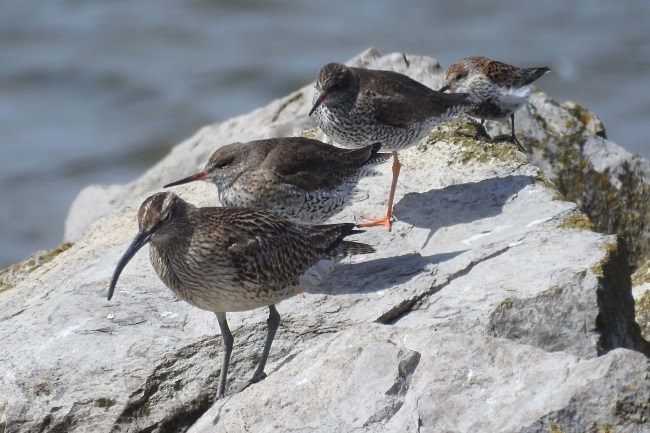
Top of Page
Colour Ring Report
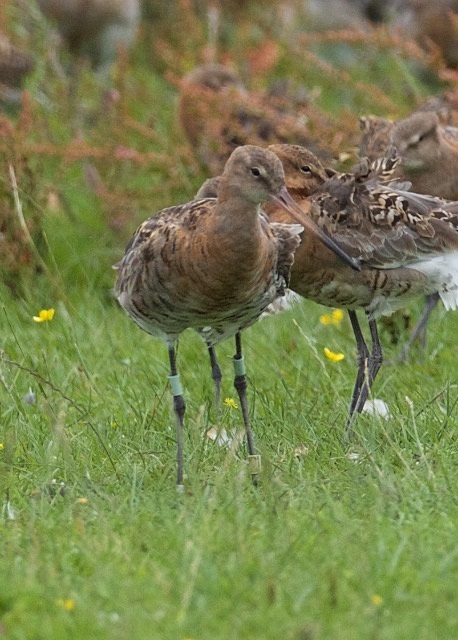
Black-tailed Godwits
The number of colour ringed Black-tailed Godwits was
disappointing this spring, total numbers were reasonably high but there
was obviously very little movement of birds as we just saw a handful of
ringed birds day after day, and all ones which we had recorded dozens
of times before. I detail two of them:
L//L-L An
unusual combination of three Light green rings.
Ringed as a chick in June 2003 in Iceland making this bird 16 years old
and our oldest of the regularly seen colour-ringed birds.
First recorded on the Dee estuary in 2005 it has been recorded over 220
times since, mostly at Thurstaston Shore, Gilroy Scrape and Caldy
Wildfowl Collection.
This spring, 2019, it was observed on a rare trip north to the Ribble
estuary in March before returning to Burton Mere Wetlands in early
April followed by three records at Caldy. Unusually, the moulting flock
moved to the Benty Farm fields on Thurstaston Hill for a few days and
L//L-L was spotted there on April 26th shortly after which they
must have flown to Iceland.
OY-RN
Orange over Yellow/Red over Black.
Ringed as a chick in Iceland in June 2017.
We always look forward to the arrivals of juveniles and this was one of
the first recorded in 2017 arriving at Caldy Wildfowl Collection on
August 7th.
It stayed at Caldy until mid-October before moving to Marshside RSPB
(Southport) and by March 2018 it was at Lytham.
Being only one year old it didn't return to Iceland in 2018 and was
back at Caldy in late June where it stayed until the end of October
with the odd sighting on Thurstaston Shore.
There were no other records until April 1st 2019 when it was again in
the Caldy Wildfowl collection all that month. It may possibly have
flown to Iceland this summer but likely won't breed until 2020.
Oystercatcher
Another Icelandic ringed Oystercatcher with an interesting history.
RO-W(CA) Red
over Orange/White ring with letters CA
Ringed in south-west Iceland (Reykjanes peninsula) on June 29th 2016.
Recorded at Kimnel Bay, Conwy, in March 2017.
Recorded at Pembry Harbour, south Wales, on August 13th 2018.
Note: Pembry Harbour is on the outer
edge of Burry Inlet notorious for the 10,000 Oystercatchers culled
there in the 1970s, I quote the BTO "Lack of understanding of the
relationship between shellfish-eating birds and shellfish stocks led to
the culling of approximately 10,000 Oystercatchers". This was before
SPA's, Ramsar and SSSI's!
Recorded at Thurstaston shore on June 13th and 14th 2019.
Grey Plover
With around 140 Grey Plovers now colour ringed over the past two years at Altcar we should see a lot more of these. Here is the latest sighting:
Oflag(TV) -
Orange flag with letters TV.
Ringed at Altcar on March 30th 2018.
Recorded at Formby Point on April 17th 2019 and Southport on May 3rd
2019.
Recorded on Heswall Shore on May 30th 2019.
Knots
I'm hoping to write a detailed analysis of all the colour-ringed Knot records from the past couple of years of which there have been several hundred. Around 1,000 have been ringed with Orange flags at Altcar, 400 have been ringed with Yellow flags in Norway in May 2019 to add to the many already ringed with Yellow flags in both Iceland and Norway plus hundreds ringed by the Dutch on the Waddensea - a lot of data!!
Here are details of two which were spotted in
Iceland in May:
Ringed at Altcar on September 22nd 2017.
Recorded at Thurstaston in November and December 2017 and then at West Kirby in January 2018.
Im March and April 2018 it was at Crosby where it returned after breeding in September 2018.
It was recorded again at Thurstaston from October to December 2018 and March 2019 at Southport.
This bird was observed at Hitarnes (south shore of the Snaefellness Peninsula) in west Iceland on May 14th 2018 and in the exact same spot almost a year later on May 16th 2019.
Oflag (ELU)
Ringed at Altcar on March 30th 2018.
Recorded at Thurstaston in November 2018 and at Southport March 2019.
Like 5Y it has been observed twice in Iceland this time at Skogarnes (just down the coast from Hitarnes) on May 20th 2018 and, again, the exact same spot almost a year later on May 17th 2019.
It seems Knot are not only site faithful on their wintering grounds but on migration as well.
Little Tern
ZBA on Yellow Ring.Fitted with colour-ring ZBA at Gronant in 2018, but found to have a metal ring also fitted at Gronant in 1993, making it the oldest Little Tern ever recorded in the world!
Also recorded on June 15th 2019 at Gronant, making it 26 years old (photo below).
Many colour-ringed Little Terns have already been recorded and new ones ringed in 2019 at Gronant, this year some are being fitted with geo-locators which will no doubt bring a load of exciting data and probably some surprises.
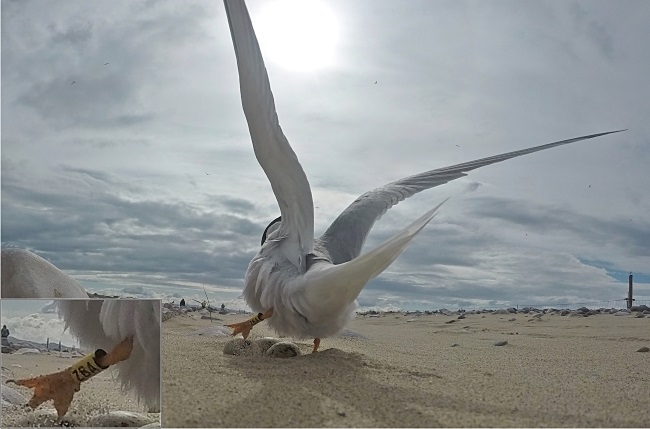
Colour-ringed birds were recorded by Richard Smith, Steve Hinde and Dave Winnard on the Dee estuary and the Little Tern Wardens at Gronant. In Iceland the two Knot mentioned were recorded by Carole Davis and Bernard Siddle.
June Bird News
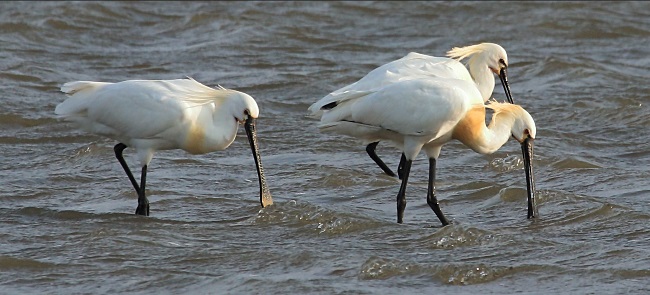
The Spoonbills increased to four then took to feeding off Parkgate for
the last ten days of the month. Ten Great Egrets were observed flying
to roost past Denhall Quay on the 8th and one or two Cattle Egrets have
been regular. The first Spotted Redshank was seen back at Burton Mere
Wetlands on the 16th and up to seven have been recorded since, also a
couple of Wood Sandpipers and Greenshanks, a male Ruff plus both
Common and Green Sandpipers there. I don't have any figures but there
have been plenty of young waders and broods of both Shovellers and
Tufted duck. Quails have been heard at various sites including
Puddington and Gronant.
Whimbrels have been present all month at Heswall
with at least three, and by the end of the month over 100 Black-tailed
Godwits in breeding plumage had returned to Caldy. Gulls had began to
increase in number by the month-end including a Mediterranean Gull at
Meols with two at Heswall.
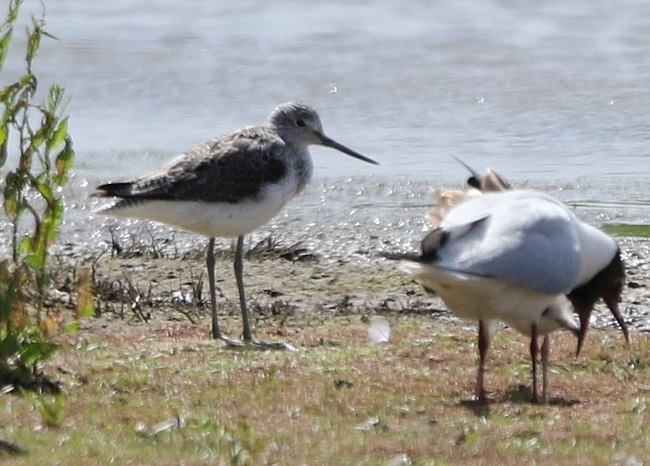
Sea-watching has been generally quiet but there were
a few days when Gannets and Manx Shearwaters were in sight, also two
Puffin and an Arctic Skua off Hilbre early in the month. A male Eider
was off Heswall and a female off Hilbre.
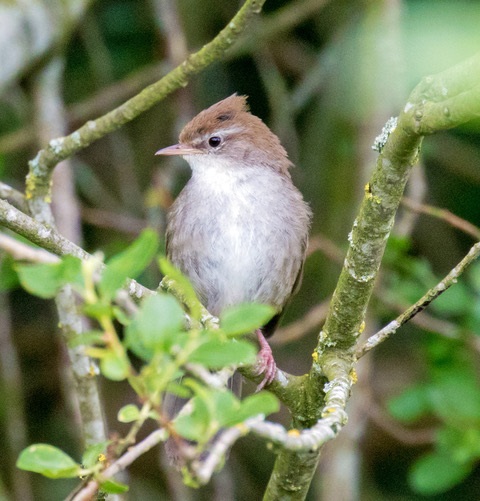
172 pairs of Little Terns were counted nesting at Gronant on the 19th, an increase of one on last year's record, and 250 chicks have been metal ringed (also a record high) with some also being given a colour ring. We are hopeful that we will beat the 2010 record of 216 fledglings. 412 Common Tern nests have been counted at Shotton, a good increase on last year's 349 nests.
Top of Page
What to expect in July
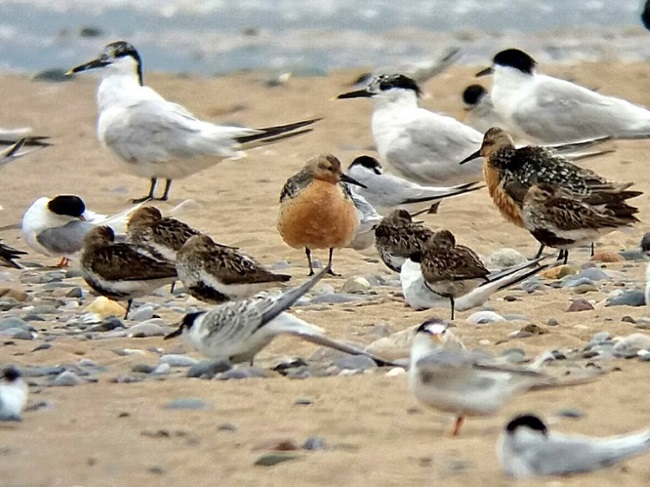
A visit to Gronant is also worthwhile to see the fledged Little Tern chicks scattered on the beach, we hope and expect another good breeding season. It's also a great place to see returning waders many of which will still be in summer plumage - Dunlin and Sanderling in particular but also a few Knot and Bar-tailed Godwits, look out for all these at Hoylake and West Kirby as well. All these sites will also see a big build-up of gulls with adult Mediterranean Gulls looking splendid in breeding plumage, and with several pairs breeding at Burton we may see several juveniles.
Whimbrels will also be returning (see above article) and Burton Mere Wetlands and Parkgate will be good places to see Spotted Redshanks in their stunning black breeding plumage. Common Sandpipers can turn up anywhere with Heswall and Connah's Quay often having multiple sightings this month. Burton Mere Wetlands seems to have become a post-breeding staging post for Little Ringed Plovers in recent years and we should have several there.
Forthcoming Events
July Highest Spring Tides (Liverpool)
Also see Tides page.
4th July, 13.51hrs (BST), 9.4m.
5th July, 14.40hrs (BST), 9.4m.
Forthcoming Events
Organised by the Wirral Ranger Service , Flintshire Countryside Service and the RSPB (Dee Estuary): All these events and walks have bird interest, even those not advertised specifically for birdwatching. No need to book for these events unless specified - please check below.
10am start, Price: £5 per person / £4 RSPB members / normal reserve entry charges also apply to non-members.
Join our friendly, knowledgeable volunteer, Richard for a leisurely amble around much of Burton Mere Wetlands, including the unmissable viewpoint at the end of the Hillfort Trail on Burton Point. Take in the sights and sounds, learn more about the wildlife that thrives here, the work we do to give nature a home and the remarkable history of the estuary.
Great for first time visitors or those looking to brush up on their identification skills; with constant changes as we move through the seasons, it's impossible to predict what might be seen. Summer may be a quieter time for birds since they finish defending territories as breeding season ends, but the growing avocet chicks and fledged little egrets and herons loafing close to the hides are great to watch. Warm sunny days will bring out the various dragon and damselflies that make their home on the reserve, along with butterflies and basking common lizards! Some birds begin their return migration just as we are getting settled into summer so sometimes unexpected birds may be found.
Booking not essential, but places are limited. A reasonable level of fitness and sturdy footwear are required. Walks typically last up to 3 hours, weather permitting.
Telephone: 0151 353 2720.